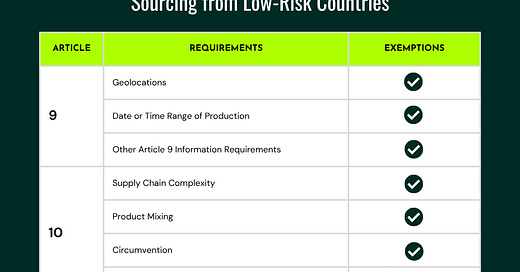Latest EUDR updates: Guidance on sourcing from Low Risk Countries, Transition Stock, and more
A monthly dose of EUDR news to support your compliance journey
Hello, and welcome to the June edition of our EUDR newsletter!
This month's packed newsletter includes guidance on sourcing from EUDR Low-Risk Countries, insight on EUDR Transition Stock, Due Diligence Verification Number, and bonus news from Dilify.
The Dilify team is here to provide you with the latest updates. Please do not hesitate to contact us to discuss EUDR in more detail. Click here to book a slot.
If you found this newsletter useful, share it with your colleagues and network by forwarding it to them - all they need to do is click on the subscribe button below to receive it.
At a Glance
#1 Sourcing from EUDR Low-Risk Countries
#2 EUDR Transition Stock Guidance
#3 EUDR Due Diligence Verification Number
#Bonus Dilify EUDR Supplier Risk Report
#1 Sourcing from Low-Risk countries
Operators sourcing commodities entirely from low-risk classified areas will benefit from significantly simplified due diligence obligations under Article 13 of EUDR.
What You Still Need to Do:
Collect standard Article 9 information (geolocation, legality evidence, etc.)
Assess three specific risks: supply chain complexity, circumvention, and mixing with unknown/higher-risk products
What You Can Skip:
Full risk assessment and mitigation procedures (Articles 10 and 11) - unless substantiated concerns arise that suggest potential non-compliance
If you receive any information or substantiated concerns under Article 31 indicating compliance risks, you must revert to full due diligence requirements.
This simplified approach will substantially reduce the administrative burden for operators with clean, low-risk supply chains while maintaining the regulation's protective intent.
For detailed obligations by operator type, see the Commission's FAQ section "What are my obligations as an operator?".
#2 EUDR Transition Stock Guidance
The EU has provided crucial clarification on how companies can handle existing inventory during the EUDR transition period, offering practical flexibility for managing mixed stock scenarios.
Mixing Transitional and Compliant Stock:
Companies can mix products placed on the EU market during the transition period - from June 2023 (which are exempt from EUDR) with EUDR-compliant products placed after December 30, 2025. However, you must be able to prove which specific batches fall into each category.
Key Requirements:
Documentation: Maintain clear evidence showing when each batch was originally placed on the EU market during the transition period
Compliance for New Stock: All new products entering after December 30, 2025 must meet full EUDR requirements under Article 3(a)-(c)
DDS Submission: When mixing stocks, only submit due diligence statements for the new, post-transition products - transitional stock remains exempt
#3 Due Diligence Verification Number
The European Commission has introduced an important security feature for the EUDR system: the Due Diligence Verification Number (DDV). This works as a two-factor authentication system alongside your DDS reference number.
How It Works:
The DDV is a confidential security token known only to you (or your authorised representative) and the competent authority. Both numbers must be provided together when checking existing submissions or generating new ones.
Example:
DDS Reference Number: 54EIDMCJEWJMX9583 (for customs declarations)
Verification Number (DDV): AERVICH7W (for secure verification)
Key Points for Your Business:
Store Both Numbers Securely: Losing either makes verification impossible
Share Confidentially: When providing DDS information to downstream partners, include both numbers through secure channels only
Required for Access: You need both to check submission status or create related entries
#Bonus Dilify EUDR Supplier Risk Report
We're excited to introduce our new EUDR Supplier Risk Assessment service, designed to help you evaluate and monitor your supplier network against EUDR requirements. This offering provides detailed risk reports for each supplier, enabling informed decision-making and proactive risk management.
What Our Supplier Risk Reports Cover:
Geographic & Compliance Analysis: Country risk classification, local deforestation trends, legal frameworks, and enforcement capacity assessment
Supply Chain Maturity: Evaluation of traceability systems, documentation quality, geolocation accuracy, and due diligence sophistication
Operational & Future Readiness: December 2025 EUDR preparedness and capacity for meeting ongoing requirements
Actionable Recommendations: Specific guidance on supplier engagement strategies, required improvements, and alternative sourcing options where risks are unacceptable





